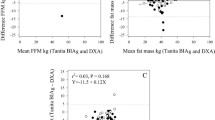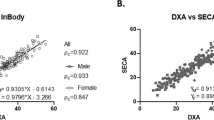Abstract
Bioelectrical impedance analysis (BIA) is an affordable, non-invasive, easy-to-operate, and fast alternative method to assess body composition. However, BIA tends to overestimate the percent body fat (%BF) in lean elderly and underestimate %BF in obese elderly people. This study examined whether proximal electrode placement eliminates this problem. Forty-two elderly men and women (64–96 years) who had a wide range of BMI [22.4 ± 3.3 kg/m2 (mean ± SD), range 16.8–33.9 kg/m2] and %BF (11.3–44.8%) participated in this study. Using 2H and 18O dilutions as the criterion for measuring total body water (TBW), we compared various BIA electrode placements; wrist-to-ankle, arm-to-arm, leg-to-leg, elbow-to-knee, five- and nine-segment models, and the combination of distal (wrists or ankles) and proximal (elbows or knees) electrodes. TBW was most strongly correlated with the square height divided by the impedance between the knees and elbows (H 2/Z proximal; r = 0.965, P < 0.001). In the wrist-to-ankle, arm-to-arm, leg-to-leg, and five-segment models, we observed systematic errors associated with %BF (P < 0.05). After including the impedance ratio of the proximal to distal segments (P/D) as an independent variable, none of the BIA methods examined showed any systematic bias against %BF. In addition, all methods were able to estimate TBW more accurately (e.g., in the wrist-to-ankle model, from R 2 = 0.90, SEE = 1.69 kg to R 2 = 0.94, SEE = 1.30 kg). The results suggest that BIA using distal electrodes alone tends to overestimate TBW in obese and underestimate TBW in lean subjects, while proximal electrodes improve the accuracy of body composition measurements.




Similar content being viewed by others
References
Baumgartner RN (1996) Electrical impedance and total body electrical conductivity. In: Roche AF, Heymsfield AB, Lohman TG (eds) Human body composition. Human Kinetics, pp 79–108
Baumgartner RN, Heymsfield SB, Lichtman S et al (1991) Body composition in elderly people: effect of criterion estimates on predictive equations. Am J Clin Nutr 53:1345–1353
Baumgartner RN, Ross R, Heymsfield SB (1998) Does adipose tissue influence bioelectric impedance in obese men and women? J Appl Physiol 84:257–262
Blanc S, Colligan AS, Trabulsi J et al (2002) Influence of delayed isotopic equilibration in urine on the accuracy of the H-2(2) O-18 method in the elderly. J Appl Physiol 92:1036–1044
Calling S, Hedblad B, Engstrom G et al (2006) Effects of body fatness and physical activity on cardiovascular risk: risk prediction using the bioelectrical impedance method. Scand J Public Health 34:568–575
Cooper AR, Page A, Fox KR et al (2000) Physical activity patterns in normal, overweight and obese individuals using minute-by-minute accelerometry. Eur J Clin Nutr 54:887–894
Cornish BH, Eles PT, Thomas BJ et al (2000). The effect of electrode placement in measuring ipsilateral/contralateral segmental bioelectrical impedance. In: In vivo body composition studies, vol 904. pp 221–224
Coward WA (1990) Calculation of pool sizes and flux rates. In: Prentice AM (ed) The doubly-labelled water method for the measurement of energy expenditure. International Atomic Energy Agency, Vienna, Austria, pp 48–65
Dempster WT, Gaughran GRL (1967) Properties of body segments based on size and weight. Am J Anat 120:33–54
Deurenberg P, van der Kooij K, Evers P et al (1990) Assessment of body composition by bioelectrical impedance in a population aged greater than 60 y. Am J Clin Nutr 51:3–6
DeVita P, Hortobagyi T (2003) Obesity is not associated with increased knee joint torque and power during level walking. J Biomech 36:1355–1362
Efron B (1983) Estimating the error rate of a prediction rule: improvement on cross-validation. J Am Stat Assoc 78:316–331
Evans WD, McClagish H, Trudgett C (1998) Factors affecting the in vivo precision of bioelectrical impedance analysis. Appl Radiat Isot 49:485–487
Franckowiak SC, Fontaine K, Andersen RE (2003) Comparison of proximal and distal placements of electrodes to assess body composition by bioelectrical impedance in obese adults. J Strength Cond Res 17:522–526
Frisard MI, Greenway FL, DeLany JP (2005) Comparison of methods to assess body composition changes during a period of weight loss. Obes Res 13:845–854
Gudivaka R, Schoeller DA, Kushner RF (1994) Effect of body position, electrode placement and time on prediction of total body water by multifrequency bioelectrical impedance analysis. Age Nutr 5:111–117
Haapala I, Hirvonen A, Niskanen L et al (2002) Anthropometry, bioelectrical impedance and dual-energy X-ray absorptiometry in the assessment of body composition in elderly Finnish women. Clin Phys Physiol Meas 22:383–391
Hansen RD, Allen BJ (2002) Habitual physical activity, anabolic hormones, and potassium content of fat-free mass in postmenopausal women. Am J Clin Nutr 75:314–320
Hughes VA, Roubenoff R, Wood M et al (2004) Anthropometric assessment of 10-y changes in body composition in the elderly. Am J Clin Nutr 80:475–482
Ishida Y, Kanehisa H, Carroll JF et al (1997) Distribution of subcutaneous fat and muscle thicknesses in young and middle-aged women. Am J Human Biol 9:247–255
Ishiguro N, Kanehisa H, Miyatani M et al (2005) A comparison of three bioelectrical impedance analyses for predicting lean body mass in a population with a large difference in muscularity. Eur J Appl Physiol 94:25–35
Ishiguro N, Kanehisa H, Miyatani M et al (2006) Applicability of segmental bioelectrical impedance analysis for predicting trunk skeletal muscle volume. J Appl Physiol 100:572–578
Janssen I, Heymsfield SB, Baumgartner RN et al (2000) Estimation of skeletal muscle mass by bioelectrical impedance analysis. J Appl Physiol 89:465–471
Kanazawa M, Yoshiike N, Osaka T et al (2002) Criteria and classification of obesity in Japan and Asia-Oceania. Asia Pacific J Clin Nutr 11:S732–S737
Kushner RF, Gudivaka R, Schoeller DA (1996) Clinical characteristics influencing bioelectrical impedance analysis measurements. Am J Clin Nutr 64:423S–427S
Kyle UG, Genton L, Karsegard L et al (2001) Single prediction equation for bioelectrical impedance analysis in adults aged 20–94 years. Nutrition 17:248–253
Kyle UG, Bosaeus I, De Lorenzo AD et al (2004) Bioelectrical impedance analysis–part I: review of principles and methods. Clin Nutr 23:1226–1243
Levine JA, Lanningham-Foster LM, McCrady SK et al (2005) Interindividual variation in posture allocation: possible role in human obesity. Science 307:584–586
Lukaski HC (1993) Comparison of proximal and distal placements of electrodes to assess human body composition by bioelectrical impedance. Basic Life Sci 60:39–43
Meng XL, Rosenthal R, Rubin DB (1992) Comparing correlated correlation-coefficients. Psychol Bull 111:172–175
Mitsui T, Shimaoka K, Tsuzuku S et al (2006) Accuracy of body fat assessment by bioelectrical impedance in Japanese middle-aged and older people. J Nutr Sci Vitaminol 52:154–156
Miyatani M, Kanehisa H, Fukunaga T (2000) Validity of bioelectrical impedance and ultrasonographic methods for estimating the muscle volume of the upper arm. Eur J Appl Physiol 82:391–396
Miyatani M, Kanehisa H, Masuo Y et al (2001) Validity of estimating limb muscle volume by bioelectrical impedance. J Appl Physiol 91:386–394
Nakamura H, Fukushima H, Miwa Y et al (2006) A longitudinal study on the nutritional state of elderly women at a nursing home in Japan. Intern Med 45:1113–1120
Neovius M, Hemmingsson E, Freyschuss B et al (2006) Bioelectrical impedance underestimates total and truncal fatness in abdominally obese women. Obesity 14:1731–1738
Organ LW, Bradham GB, Gore DT et al (1994) Segmental bioelectrical-impedance analysis—theory and application of a new technique. J Appl Physiol 77:98–112
Pateyjohns IR, Brinkworth GD, Buckley JD et al (2006) Comparison of three bioelectrical impedance methods with DXA in overweight and obese men. Obesity 14:2064–2070
Racette SB, Schoeller DA, Luke AH et al (1994) Relative dilution spaces of 2H- and 18O-labeled water in humans. Am J Physiol Endocrinol Metab 267:E585–E590
Reddy GN, Saha S (1984) Electrical and dielectric properties of wet bone as a function of frequency. IEEE Trans Biomed Eng 31:296–303
Ritz P (2001) Chronic cellular dehydration in the aged patient. J Gerontol A Biol Sci Med Sci 56:M349–M352
Ruhl CE, Harris TB, Ding J et al (2007) Body mass index and serum leptin concentration independently estimate percentage body fat in older adults. Am J Clin Nutr 85:1121–1126
Scheltinga MR, Jacobs DO, Kimbrough TD et al (1992) Identifying body-fluid distribution by measuring electrical-impedance. J Trauma 33:665–670
Schoeller DA, van Santen E, Peterson DW et al (1980) Total body water measurement in humans with 18O and 2H labeled water. Am J Clin Nutr 33:2686–2693
Schwan HP, Kıaz CF (1956) The conductivity ofliving tissues. Ann N Y Acad Sci 65:1007–1013
Slinde F, Bark A, Jansson J et al (2003) Bioelectrical impedance variation in healthy subjects during 12 h in the supine position. Clin Nutr 22:153–157
Stahn A, Terblanche E, Strobel G (2007) Modeling upper and lower limb muscle volume by bioelectrical impedance analysis. J Appl Physiol 103:1428–1435
Tanaka NI, Miyatani M, Masuo Y et al (2007) Applicability of a segmental bioelectrical impedance analysis for predicting the whole body skeletal muscle volume. J Appl Physiol 103:1688–1695
Tsutsui T, Muramatsu N (2007) Japan’s universal long-term care system reform of 2005: containing costs and realizing a vision. J Am Geriatr Soc 55:1458–1463
van Marken Lichtenbelt WD, Westerterp KR, Wouters L et al (1994) Validation of bioelectrical-impedance measurements as a method to estimate body-water compartments. Am J Clin Nutr 60:159–166
Wannamethee SG, Shaper AG, Whincup PH (2005) Body fat distribution, body composition, and respiratory function in elderly men. Am J Clin Nutr 82:996–1003
Yamada Y, Kimura M, Nakamura E et al (2007) Limb muscle mass decrease with aging in Japanese men and women aged 15–97 yr. Jpn J Phys Fit Sports Med (Japanese with English abstract) 56:461–471
Yamada Y, Yokoyama K, Noriyasu R et al (2009) Light-intensity activities are important for estimating physical activity energy expenditure using uniaxial and triaxial accelerometers. Eur J Appl Physiol 105:141–152
Yang X, Telama R, Viikar J et al (2006) Risk of obesity in relation to physical activity tracking from youth to adulthood. Med Sci Sports Exerc 38:919–925
Acknowledgments
The authors would like to express their thanks to Prof. Dale A. Schoeller (Nutritional Sciences, University of Wisconsin, Madison) for his helpful discussions and editing of the entire manuscript. The authors also thank all of the individuals who participated in this study. This study was supported by a research grant awarded to MK from the Japanese Ministry of Education, Culture, Sports, Science, and Technology (18300218) and a research fellowship awarded to YY from the Japan Society for the Promotion of Science for Young Scientists (19-1440).
Author information
Authors and Affiliations
Corresponding author
Rights and permissions
About this article
Cite this article
Yamada, Y., Masuo, Y., Yokoyama, K. et al. Proximal electrode placement improves the estimation of body composition in obese and lean elderly during segmental bioelectrical impedance analysis. Eur J Appl Physiol 107, 135–144 (2009). https://doi.org/10.1007/s00421-009-1106-6
Accepted:
Published:
Issue Date:
DOI: https://doi.org/10.1007/s00421-009-1106-6




